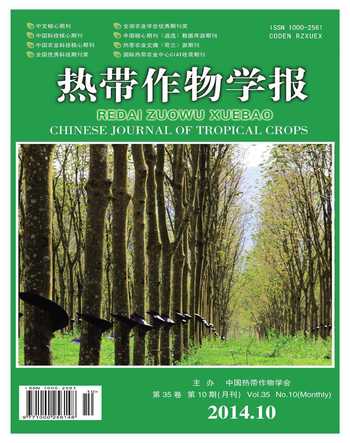木薯蔗糖合酶(SuSy)基因的表达分析及SuSy1和SuSy4编码序列的克隆
方开星等
摘 要 依据拟南芥6个蔗糖合酶基因序列搜索木薯基因组数据库,获得了6个木薯蔗糖合酶基因亚型。 将6个木薯蔗糖合酶基因亚型的外显子-内含子结构进行分析,结合其它物种蔗糖合酶基因的氨基酸序列构建进化树,将木薯蔗糖合酶基因可分为三类,分别为 SuSy1/SuSy4,SuSy2/SuSy3和SuSy5/SuSy6。以木薯KU50的功能叶和5个不同时期块根的RNA为模板,利用RT-PCR的方法对蔗糖合酶基因家族进行表达分析,确定了SuSy1和SuSy4高表达的亚型,克隆并获得了SuSy1和SuSy4基因的编码区序列,对获得的序列进行同源性和功能结构域分析表明,2条序列的氨基酸同源性为97%,并且有相同的功能结构域。
关键词 木薯;蔗糖合酶;RT-PCR;基因克隆
中图分类号 TS231 文献标识码 A
Abstract According to the six subunit sequences of sucrose synthase gene in Arabidopsis, six sucrose synthase genes were identified in cassava by searching the cassava genome database. The exon-intron structures of the six sucrose synthases in cassava were analyzed and the evolutiontree was then constructed based on the sucrose synthase protein sequences from various species which divided the sucrose synthase genes into three subgroups: SuSy1/SuSy4, SuSy2/SuSy3, and SuSy5/SuSy6, respectively. Expression analysis of six different SuSy subunits through RT-PCR in cassava KU50 function leave and roots of five different periods, the result showed that SuSy1 and SuSy4 were high expression subunits. And then, the full-length CDS of SuSy1 and SuSy4 were cloned and the homology and functional domain were analysis, the results showed that the homology between two sequences were 97% and two sequences had the same functional domain.
Key words Cassava; Sucrose synthase; Prokaryotic expression; Gene cloning
doi 10.3969/j.issn.1000-2561.2014.10.010
植物蔗糖合成酶(Sucrose Synthase;SuSy E.C.2.4.4.13)是由分子量约为83~100 ku的亚基构成的四聚体[1],是植物淀粉代谢的关键酶之一,催化以下可逆反应:果糖+UDPG←→蔗糖+UDP。SuSy主要在植物体内有2种存在形式,大部分以可溶状态存在于细胞质中,不溶性的SuSy则附着在细胞膜上。
自1955年Cardini[2]等首次在小麦胚芽中发现以来,目前国内外研究者已经成功地将SuSy基因从马铃薯[3]、玉米[4]、甜菜[5]、胡萝卜[6]和甘蔗[7]等作物中克隆出来。Zrenner[8]的研究结果表明,在马铃薯块茎中反义表达SuSy,淀粉累积受到抑制,总干重下降,可溶性蛋白减少,产量下降。Baroja-Femandez E[9]在马铃薯中过表达SuS4,发现马铃薯块茎中蔗糖合酶的酶活提高,ADPG和UDPG含量提高,淀粉含量增加,马铃薯干重也比野生型的多。在番茄中反义表达SuSy,蔗糖合酶活性明显下降,蔗糖卸载能力降低,植株生长率减慢,座果数减少,成熟后每株的结果数下降[10]。说明SuSy参与调控蔗糖的输入,影响植株的生长发育。Chourey等[11]在玉米中研究发现,有3个基因编码SuSy基因,Shl突变可使SuSy酶活性急剧下降,使胚乳细胞发育受阻,淀粉含量下降。这些结果均表明SuSy能够影响库容并参与淀粉的合成。
木薯是热带、亚热带地区一种重要的高淀粉作物[12]。木薯块根的化学成分、淀粉含量及特征对于全球热带地区的食物、生物能源与工业原料生产都具有重要意义[13]。迄今为止,对木薯淀粉生物合成途径及相关酶基因的研究少数报道,而有关木薯蔗糖合酶的研究未见报道。本文对木薯基因组数据库搜索,挖掘潜在的木薯SuSy亚型,并通过表达差异分析筛选出高表达的亚型,可为进一步研究木薯SuSy的功能及调控奠定基础。
1 材料与方法
1.1 材料
1.1.1 植物材料 利用高淀粉木薯品种KU50进行木薯蔗糖合酶基因家族成员的表达分析。木薯品种KU50分别取出芽后70、120、180、240、280 d的块根和180 d的功能叶为研究材料。每次采样选取3株长势相近的木薯植株,取3株相同的组织部位混匀后迅速放入液氮罐速冻,回实验室后置于-80 ℃冰箱保存或马上进行RNA提取。
1.1.2 菌株和试剂 大肠杆菌菌株DH5α为作者所在实验室保存。RNA plant Plus植物RNA提取试剂购自天根生化科技,Prime STAR HS DNA Polymerase和反转录试剂盒[FasT Quant RT Kit(With gDNase)]购自宝生物,普通琼脂糖凝胶DNA片段回收试剂盒(Gel Extraction Kit)购自OMEGA公司,其他药品试剂均为进口或国产分析纯。
1.2 方法
3 讨论与结论
蔗糖合酶是植物中一个重要的代谢酶。能够将光合作用产生的蔗糖分解成合成淀粉的底物,从而影响库容大小。自从1955年在小麦中发现以来,已在45个物种中发现80多个SuSy成员。在拟南芥和水稻中均有6个蔗糖合酶基因亚型。通过对木薯基因组进行Blast,在木薯中确定了6个木薯蔗糖合酶成员。已知SuSy家族可分为双子叶SuSyA族、双子叶SuSyl族、单子叶族、NG(New Group)族四个亚族,通过进化树分析可以把木薯SuSy基因家族分为双子叶SuSyA族、双子叶SuSyl族、NG(New Group)族三个亚族,其中SuSy1和SuSy4与杨树的SuSy1同源性高,它们属于SuSyl族;SuSy2和SuSy3与蓖麻蔗糖合酶2和杨树SuSy3同源性高,属于双子叶SuSyA族;SuSy5和SuSy6和拟南芥SuSy6同源性高,属于NG(New Group)族。
通过对木薯蔗糖合酶基因家族的内含子-外显子结构进行分析可知,蔗糖合酶6个亚基可能是由3个基因进化而来,其中木薯SuSy1和SuSy4是由同一个基因进化而来;SuSy 2和SuSy3 ,SuSy5和SuSy6分别是由另外一个基因进化而来。原始基因通过突变改变原来的碱基或者通过插入和缺失基因片段从而进化成另外一个基因。木薯SuSy1和SuSy4编码的开放阅读框长度及氨基酸个数一样,它们之间的差异是由个别碱基突变而导致氨基酸的变异,而木薯SuSy3是通过缺失外显子和5′UTR与SuSy2区别开来。
不同植物具有不同数目的蔗糖合酶基因,而且表达也各异。如玉米中存在3个SuSy[14],SH1能够在幼苗和胚乳中表达;SuS1在 幼苗、胚、根、茎和叶中表达[15-16];SuS3在胚乳、胚珠、根和幼芽中表达。胡萝卜中有2个SuSy基因,一个在花中特异表达,另一个在茎、根、花和成熟的种子中表达[17]。另外在拟南芥、水稻、菜豆、梨、胡萝卜、玉米、马铃薯、番茄、甜菜和甘蔗中都有蔗糖合酶基因家族表达分析的报道[18-23]。本研究中对木薯SuSy基因家族的6个不同亚型在不同组织和部位进行表达分析,结果表明,木薯SuSy基因家族的基因表达同其他物种一样存在特异性,SuSy1,SuSy3和SuSy4在180 d时,功能叶和不同时期的块根中均有表达,且SuSy1和SuSy4的表达量明显高于其他亚型的表达,这说明SuSy1和SuSy4可能在功能叶和块根的蔗糖分解过程中起到主要作用;在功能叶和块根中蔗糖合酶均有表达,说明蔗糖的分解代谢在功能叶和块根中同时存在,因此蔗糖合酶在“源”和“库”器官中均起到重要作用。
参考文献
[1] Moriguchi T, Yamaki S. Purification and characterization of sucrose synthase from peach(Prunuspirsica)fruit[J]. Plant Cell Physiol, 1988, 29: 1 361-1 366.
[2] Cardini C E, Leloir L F, Chiriboga J. The bio-synthesis of sucrose[J]. J Biol Chem, 1955, 241: 149-155.
[3] Salanoubat M, Billiard G. Molecular cloning and sequencing of sucrose synthase cDNA from potato: preliminary characterization of sucrose synthase mRNA distribution[J]. Gene, 1987, 60: 47-56.
[4] McCarty D R, Shaw J R, Hannah L C. The cloning genetic mapping and expression of the constitutive sucrose synthase locus of maize[J]. Proceed National Academy Sci USA, 1986, 88: 9 099-9 103.
[5] Hesse H, Willmitzer L. Expression analysis of a sucrose synthase gene from sugar beet(Beta vulgaris L.)[J]. Plant Mol Biol, 1996, 30: 863-872.
[6] Sebkova V, Unger C, Hardegger M. Biochemical, physiological, and molecular characterization of sucrose synthase from Daucus carota[J]. Plant Physiology, 1955, 108: 75-83.
[7] Lingle S E, Dyer j M. Cloning and expression of sucrose synthase cDNA from sugarcane[J]. Plant Physiology, 2001, 158: 129-131.
[8] Zrenner R, Salanoubat M, Willmitzer L, et al. Evidence of the crucial role of sucrose synthase for sink strength using transgenic potato plants(Solariumtuberosum L.)[J]. Plant J, 1995, 7: 97-107.
[9] Baroja-Femandez E, Munoz F J, Montero M, et al. Enhancing sucrose synthase activity in transgenic potato(Solarium tuberosum L.)tubers results in increased levels of starch, ADP-glucose and UDP-glucose and total yield[J]. Plant Cell Physiol, 2009, 50(9): 1 651-1 662.
[10] D'Aoust M A, Yelle S, Quoc B N. Antisense inhibition of tomato fruit sucrose synthase decreases fruit setting and the sucrose unloading capacity of young fruit[J]. Plant Cell, 1999, 11: 2 407-2 418.
[11] Chourey P S, Taliercio E W, Carlson J. Genetic evidence that the two isozymes of sucrose synthase present in developing maize endosperm are critical, one for cell wall integrity and the other for starch biosynthesis[J]. Mol Gen Genet, 1998, 259(1): 88-96.
[12] Jansson C, Westerbergh A, Zhang J M, et al. Cassava, a potential biofuel crop in(the)People's Republic of China[J]. Applied Energy, 2009, 86: s95-s99.
[13] 杨丽英, Sriroth K, Piyachomkwan K, 等. 泰国木薯淀粉特性研究[J]. 云南大学学报(自然科学版), 2003, 25(增刊): 110-114.
[14] Medberry S L, Olszewski N E. Identification of cis-elements involved in commelina yellow mottle virus promoter activity[J]. Plant J, 1993, 3: 619-626.
[15] Wu B, Pan R Q, Lu R, et al. Deletion analysis and functional studies of the promoter from commelina yellow mottle virus[J].Acta Microbiologica sinica, 1999, 39: 15-21.
[16] Yuan Z Q, Jia Y T, Wu J H, et al. Comparison of three phloem-specific promoters in transgenic tobacco plants[J]. J Agriculurual Biotechnology, 2002, 10(1): 6-9.
[17] Bostwick D E, Dannenhoffer J M, Skaggs M I, et al. Pumpkin phloem lectin genes are specifically Expressed in companion cells[J]. Plant cell, 1992, 4: 1 539-1 548.
[18] Graham M W, Craig S, Waterhouse P M. Expression patterns of vascular-specific promoters RolC and Sh in transgenic potatoes and their use in engineering PLRV-resistant plant[J].Plant Mol Biol, 1997, 33(4): 729-735.
[19] Tornero P, Conejero V, Vera P. Phloem-specific expression of a plant homeobox gene during secondary phases of vascular development[J]. Plant J, 1996, 9: 639-648.
[20] Brears T, Walker E, Coruzzi G A. Promoter sequence involved in cell-specific expression of the pea glutamine synthase GS3A gene in organs of transgenic tobacco and alfafa[J]. Plant J, 1991, 1: 235-244.
[21] Jiang H, Qin H M, Yu H M, et al. Cloning and function of the phloem protein gene promoter from cucubita maxima[J]. J Agriculural Biotechnology, 1997, 7(1): 63-68.
[22] Jiang H, Qin H M, Tian Y C. Cloning of a promoter fragment of bark storage protein gene form populous deltoids and its function in transgenic tobacco plants[J]. Scientia silvae sinicae, 1999, 35(5): 46-50.
[23] Torres-Schumann S, Ringli C, Heierli D, et al. In vitro binding of the tomato bZIP transcriptional activator VSF-1 to a regulatory element that controls xylem-specific gene expression[J]. Plant J, 1996, 9: 283-296.

